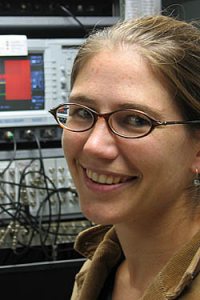
'Quantum entanglement' research published
Lilian Childress, assistant professor of physics at Bates, is one of a team of physicists who have taken an exciting step toward the practical application of a surprising phenomenon that even Albert Einstein described as “spooky.”
He was referring to “quantum entanglement,” a kind of relationship between separate, even distant, entities at the subatomic level. By measuring a variable of one such object, researchers can predict what the same kind of measurement of the other “entangled” object will reveal. Taking place at a physical scale where the familiar principles of classical physics no longer pertain, this phenomenon is explained by the counterintuitive laws of quantum mechanics.
A team of 11 physicists led by Mikhail D. Lukin of Harvard has created the first-ever entanglement of photons — the basic units of light — with solid-state materials, writes the website Science Daily. Emre Togan and Yiwen Chu, also of Harvard, are lead authors of the paper “Quantum entanglement between an optical photon and a solid-state spin qubit,” which on Aug. 5 was summarized on Science Daily and published online in the journal Nature.
“The work marks a key advance toward practical quantum networks” through which information could be transmitted over long distances, writes Science Daily. The breakthrough holds out intriguing possibilities for fields such as computing and cryptography.
The research exploits the distinctive qualities of the photon and what the researchers call a “solid-state spin qubit,” which in this case is actually a defect in the crystalline structure of certain diamonds.
Known as a nitrogen vacancy, this defect (which is also responsible for the color of pink diamonds) has a type of variability that physicists call “spin.” A property of subatomic particles, spin can take on different values similar to the binary system of ones and zeros that form bits, the building blocks of information in conventional computing. Much as information is conventionally encoded in bits, it can also be encoded in these spin states, creating so-called quantum bits or “qubits.”
Once entangled, Childress explains, photons and spin qubits are potentially complementary for use in an information network. “Entanglement with a photon, which travels at the speed of light, means that information can be transmitted over longer distances,” she says, “while working with a solid-state material like diamond is intriguing because it offers a robust physical platform for quantum memory.”
An especially intriguing behavior in quantum mechanics, the concept of entanglement for years discomfited physicists all the way up to Albert Einstein, who characterized this counterintuitive phenomenon as “spukhafte Fernwirkung” (in German, “spooky action at a distance”).
In addition to Harvard and Bates, the researchers are affiliated with the California Institute of Technology, the University of Pittsburgh, the University of Copenhagen and Texas A&M University. The work was supported by the Defense Advanced Research Projects Agency, the National Science Foundation, the National Defense Science and Engineering Graduate Fellowship program and the Packard Foundation.



